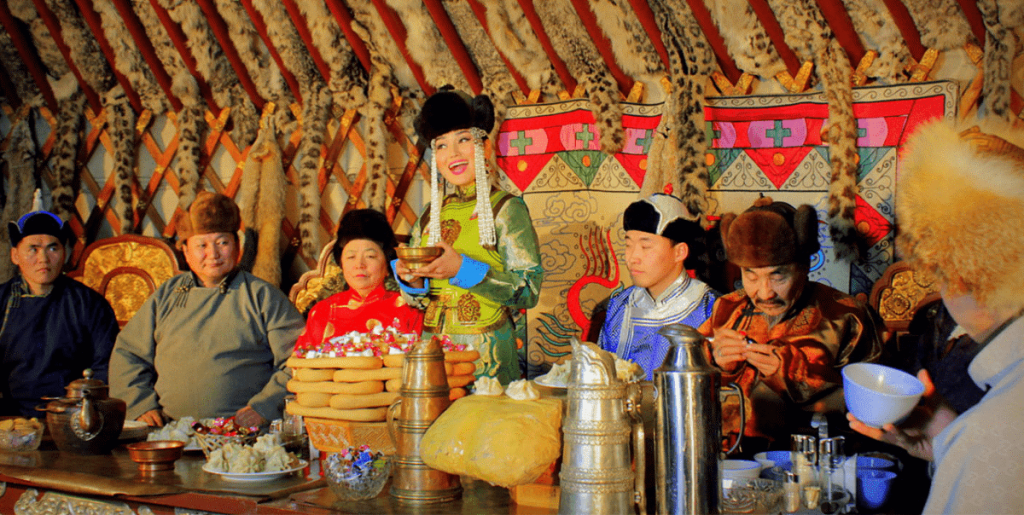
Introduction to Naadam Festival The Naadam Festival is Mongolia’s most significant and captivating celebration, held annually on July 11-13. The term “Naadam” means “game,” and the festival is rooted in three traditional “manly sports” or “eriin gurwan naadam”: wrestling, horse racing, and archery. These sports date back to the Mongol Empire, though the modern festival also commemorates Mongolia’s national revolution and independence.
While all administrative regions in Mongolia celebrate their local Naadam festivals at different times, the largest and most famous event is hosted in Ulaanbaatar, drawing thousands of tourists and international journalists every year.
Colorful Traditions and Cultural Pride During the Naadam Festival, participants and spectators showcase their cultural pride by wearing vibrant traditional attire. The celebration is a grand display of Mongolian heritage, blending ancient customs with modern enthusiasm. Recognized for its cultural significance, Naadam was inscribed on UNESCO’s Intangible Cultural Heritage List in 2010.
Traditional Mongolian Wrestling (Bökh)

Mongolian wrestling, or Bökh, is a unique folk wrestling style that distinguishes itself with no weight divisions or time limits. Wrestlers, known as “bokh” (meaning durability), aim to force their opponent to touch the ground with any part of the body other than the feet or palms.
- Attire: Wrestlers wear a tight-fitting jacket called zodog and briefs called shuudag, complemented by traditional Mongolian boots. Before matches, they don a ceremonial hat and perform an “eagle dance” ritual symbolizing strength and honor.
- Rules: Kicking and punching are prohibited, but wrestlers may use their legs to trip opponents. Matches continue until one wrestler falls or is otherwise defeated.
- Rituals: Ceremonial dances, libations of milk to spirits, and ritual songs enhance the spiritual significance of the sport.
Naadam’s wrestling tournaments can involve up to 1,024 participants, making it a spectacular and enduring competition.
Traditional Mongolian Archery

Archery is an ancient and revered sport in Mongolia, open to both men and women. Though traditional bow-making techniques have evolved, Mongolian archers still use composite bows crafted from horn and wood.
- Techniques: Arrows are made from local materials like pine, birch, or willow, with feather fletching from birds like eagles or falcons. The arrow is placed on the right side of the bow and released using a thumb ring for precision.
- Cultural Significance: Archery reflects Mongolia’s warrior heritage, with traditional techniques preserved across generations.
Traditional Mongolian Horse Racing

Mongolia hosts some of the world’s longest and toughest horse races, ranging from 5 to 30 kilometers across rugged steppe terrain. Horses are divided into age categories, and surprisingly, child jockeys (both boys and girls) ride them.
- Rituals: Before races, horses and jockeys participate in ceremonial songs and processions.
- Race Dynamics: Jockeys ride without saddles for the horse’s comfort, focusing on endurance rather than speed.
- Awards: Winners receive the prestigious title “Forehead of the Ten Thousand Race Horse,” while the last finisher is honored humorously as “Rich Belly.”
Why Visit the Naadam Festival?
Experiencing the Naadam Festival offers travelers an authentic glimpse into Mongolian culture, sports, and history. The festival is not only a celebration of athletic prowess but also a deep-rooted tradition that fosters unity and national pride.
Plan Your Trip to Mongolia
- Visit Ulaanbaatar in July to witness the main festival.
- Experience local Naadam celebrations in rural regions for a more intimate cultural encounter.
- Engage with locals, savor traditional foods, and immerse yourself in the vibrant atmosphere.
Ready to embark on a unique journey? Contact us to explore off-the-beaten-path travel experiences in Mongolia during the Naadam Festival!






